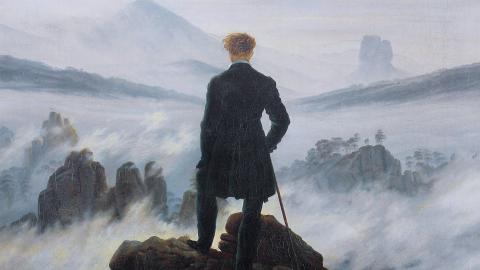A prayer without words: The story of the wanderer

A tale of silence, an icon of human solitude in the face of the forces of nature, or perhaps a memento of the great artist?
I come down from the mountains,
The valley dims, the sea roars.
I wander silently and am somewhat unhappy,
And my sighs always ask “Where?”
This is the lamenting of the Wanderer from a song composed by 19-year-old Franz Schubert to the words of G.P. Schmidt. The stranger looks for a spiritual home everywhere, but is condemned to wander forever. Schubert’s music was composed in 1821. Three years earlier, Caspar David Friedrich painted a picture that often illustrates the recordings of the Austrian composer’s song. Wanderer above the Sea of Fog also often ends up on the covers of books about German Romantic painting. It shows a man from behind, with a cane, wearing an overcoat, standing on a protruding rock. At his feet, a spectacle of nature takes place: clouds are lifting from a valley, exposing rocky ridges. Further away, on the horizon, a mountain range looms wrapped in a morning haze. No other painter has possibly ever created a comparable icon of solitude in the face of the forces of nature; no other painter has so emphatically shown the melancholy of unfulfilled hopes. Friedrich himself likened his work of art to a prayer. “Just as the pious man prays without speaking a word and the Almighty hearkens unto him, so the artist with true feelings paints and the sensitive man understands and recognises it.”
Friedrich’s painting was created 200 years ago, and we, as its viewers, rank among the more thick-witted. Accustomed to the school-level version of Romanticism, we sometimes forget that it was “the fallen religion”. Caspar David Friedrich was born in Greifswald, on the territory of the then Swedish Pomerania, in the family of a soap-boiler with a strong, Protestant history. Thanks to his first painting teacher he met the philosopher and pantheist, Thomas Thorild, and the poet, preacher and theologist Ludwig Gotthard Kosegarten. The latter praised the beauty of nature leading to the meeting with God.
Friedrich Schiller himself said in 1794 that landscape is perfect for expressing both ideas and emotions. However, Friedrich’s Tetschen Altar (1808) provoked a controversy: a simple cross on a rock surrounded by spruces against the background of the sky turning pink. The critic F.W.B. von Ramdohr was scathing when he wrote that it was “a veritable presumption, if landscape painting were to sneak into the church and creep onto the altar.” Indeed, this was supposed to be a secular landscape. Only later on did Count Anton von Thun-Hohenstein insist on placing this painting in his palace chapel. Cherubs, stalks of grains and wine chalices carved into the frame created the correct context, however Friedrich’s lonely cross covered with ivy was not so much a religious symbol as an element of the landscape. Answering his critics’ objections, the artist explained that “Jesus Christ, nailed to the tree, is turned here towards the setting sun, the image of the eternal life-giving father.” Yet this does not necessarily mean that the sun always symbolizes God in his works, and that evergreen trees should be associated with the hope of resurrection. Friedrich’s contemporaries often exaggerated the religious aspect of his works, envisaging their artificially sophisticated mysticism. Critics were doubtful as to whether being moved by the spectacle of the fog should be associated with religious elation. However, the writer Ludwig Tieck claimed that Friedrich had sensed the spirit of the era: “Friedrich expresses the religious mood and excitement that recently seems to have stirred our German world in a particular manner, in sensitive, solemn, melancholy landscape motives.”
Friedrich painted his pictures in the studio, based on earlier sketches drawn on location. His compositions are well-balanced, often symmetrical. Tree trunks mark the centre of the composition or frame it; diagonal branches do not project beyond the frame. “This insistent geometry accords with our modern sense of artistic decorum,” John Updike wrote. “If Friedrich meant to imply Presence with his controlled, emptied vistas, and we can feel only Absence, well, Absence is an old friend, and we wouldn’t know what to do with Presence if it came up and hit us in the face.”
19th-century thinkers and poets were searching for divinity in personal contemplation. Friedrich’s painterly approach was incidentally expressed by Ludwig Tieck in his early novel Franz Sternbalds Wanderungen. An old painter, a hermit, considered mad, tells the main protagonist: “I do not want to copy trees or mountains, but my soul, my mood which reigns over me at this hour, these I want to fix for myself and to communicate to those who are able to understand.” Friedrich’s landscapes are usually divided into two zones: a dark foreground with a man in contemplation, and the landscape in the background, flooded with light. One of the main stylistic tricks of the German master is the so-called Rückenfigur, a figure shown from behind. Details of the landscape become less important than the fact that it is being observed and experienced. On the other hand, we, the viewers, can only imagine the emotions and thoughts of the person we are seeing from behind.
Friedrich’s famous painting was also interpreted as a tale of silence, of a creative individual reaching the blessed state of being alone with nature and their own thoughts. The American scholar Theodore Ziolkowski said that the traveller on the rock should be seen as Goethe. Indeed, this painting is a peculiar conversation with the author of Faust. The poet asked Friedrich to paint a set of studies of clouds, according to their classification, recently published by Luke Howard. Friedrich could not accept such a challenge: scientifically systemized clouds would not convey higher, spiritual meanings anymore. For him that would be “the end of painting”. Therefore, his picture has a polemical character. Nature does not comfort, it is menacing and oppressive. The wanderer stands above a precipice.
It’s worth remembering that Wanderer above the Sea of Fog also functions in the collective imagination as a metaphor for the German conscience. It was used on the cover of Der Spiegel on the 50th anniversary of the end of World War II. From the height of the rock, the man in the painting contemplated the ghosts of Nazism. Then, on the cover of Stern in October 2015, Friedrich’s wanderer watched a sea of refugees emerging from the sea of fog. It might perhaps be that the German Romantic’s painting today is not just an allegory of artistic solitude, but also of the fog from which critical awareness emerges, as well as sensitivity to the suffering of others.
Translated from the Polish by Anna Błasiak
Reprinted with permission of Przekrój. Read the original article.





